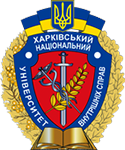To the problem of optimization of criteria for evaluating the effectiveness of providing the national security of the State
Abstract
It has been argued that the evaluation of the effectiveness of Ukrainian national security is the activities of authorized entities carried out in the prescribed manner, which aims to establish the extent to which measures implemented by the state in the relevant direction, as well as related financial, material technical and human costs, meet the goal.
It has been performed the classification of the relevant criteria, which is most appropriate to divide into the following groups: 1) financial and economic, which include: the level of shadowing of the economy; the level of GDP per capita; the ratio of public debt to GDP; the average level of wages in the state; 2) socio-cultural, in particular: the demographic situation in the country (depopulation rate); the level of legal consciousness of society and cultural development; national consent and unity; a sense of personal security; the level of support of the population of the state; 3) political: stability and effectiveness of public policy (domestic political stability); resilience to ensure a high level of readiness of society and the state to respond to a wide range of threats; the level of democracy, the formation and effectiveness of the legal framework of the rule of law; 4) indicators of combat readiness of the army: the state of the armed forces, their combat capability and combat readiness; logistical, financial support of troops; adequacy of staffing.
Emphasis has been placed on the fact that the list of these criteria is not exhaustive, as they can be expanded by a number of indicators that depend directly on the direction of national security. These criteria are an objective reflection of how effective the legislator is in this area. In addition, the implementation of appropriate evaluation requires the use of various methods: surveys, mathematical modeling, forecasting and more.
Downloads
References
Andriichuk, T. (2012). Measuring democracy: theoretical and empirical approaches. Political studies, 3, 3-11.
Bochi, A., & Povoroznyk, V. (2014). Shadow economy in Ukraine: causes and ways of overcoming. International Center for Advanced Study. http://icps.com.ua/assets/uploads/files/t_novaekonom_kaukra_ni.pdf.
Danylov, V. (2009). Features of image formation of the Armed Forces of Ukraine. Political studies, 5(38), 88-95.
Dubenko, O. I. (2009). Administrative and legal mechanism securing the safety if a person [Candidate dissertation, National University of Stat Revenue Service of Ukraine].
Grishnova, O. A., & Kharazishvili, Yu. M. (2019). Demographic security of Ukraine: indicators, level, threats. Demography and Social Economy, 2(36), 65-80.
Horlach, M. I., & Kremen, V. H. (2009). Political Science: the science of politics. Center for Educational Literature.
Karahioz, R. S. (2014). Political consent and political unity as preconditions for democratization in transitional societies. Current Policy Issues, 52, 87-193.
Komarnytskyi, V., Arifkhodzhaieva, T., Oderii, O., & Kovalenko, V. (2021). International Security: Current Situation and Ways of Improvement Legal Regulation. Jurnal Cita Hukum), 9(3), 539-550. https://doi.org/10.15408/jch.v9i3.22653.
Ortynskyi, V. L., & Riashko, V. I. (2006). Actual problems of education of cadets in higher educational institutions of the system of the Ministry of Internal Affairs of Ukraine. Lviv.
Prokhorov, A. M. (Ed.). (1989). Soviet Encyclopedic Dictionary. Soviet Encyclopedia.
Rastou, D. A. (1996). Transitions to Democracy: An Attempt at a Dynamic Model. Political studies, 5, 5-15.
Riashko, O. V. (2006). Legality in the Context of the Measures for the Prevention of Offences in the Official Activities of the Militia of Ukraine [Candidate dissertation, Kyiv National University of Internal Affairs].
Serohin, V. O., Serohina, S. H., Gryshko, L. M., & Danicheva, K. P. (2021). Recognizing and Implementing International Human Rights Standards in Domestic Legislation: An Exposure Under Ukrainian Law. Ius Humani, 10(2), 161-176. https://doi.org/https://doi.org/10.31207/ih.v10i2.291.
Sych, R. (2016). Personal security concept future personal security officers, border guards and forms of support in operational performance. Scientific Review, 5(26). http://naukajournal.org/index.php/naukajournal/article/view/862/1006.
Tsvihun, I. A. (2017). System of demographic security indicators of Ukraine. Economy and Society, 10, 552-559.
Vald, B. (2021, February 15). What is GDP: how and why it is calculated, and why this indicator is so important. Ukrainian portal. https://ucap.io/vvp/.
Zvonko, V. (2021, May 17). Suddenly there was a war, and the equipment was handed over for repair. Ukrainian Military Pages. https://www.ukrmilitary.com/2021/05/pnk--tneu.html.
Copyright (c) 2022 Y. V. Kobko

This work is licensed under a Creative Commons Attribution 4.0 International License.



